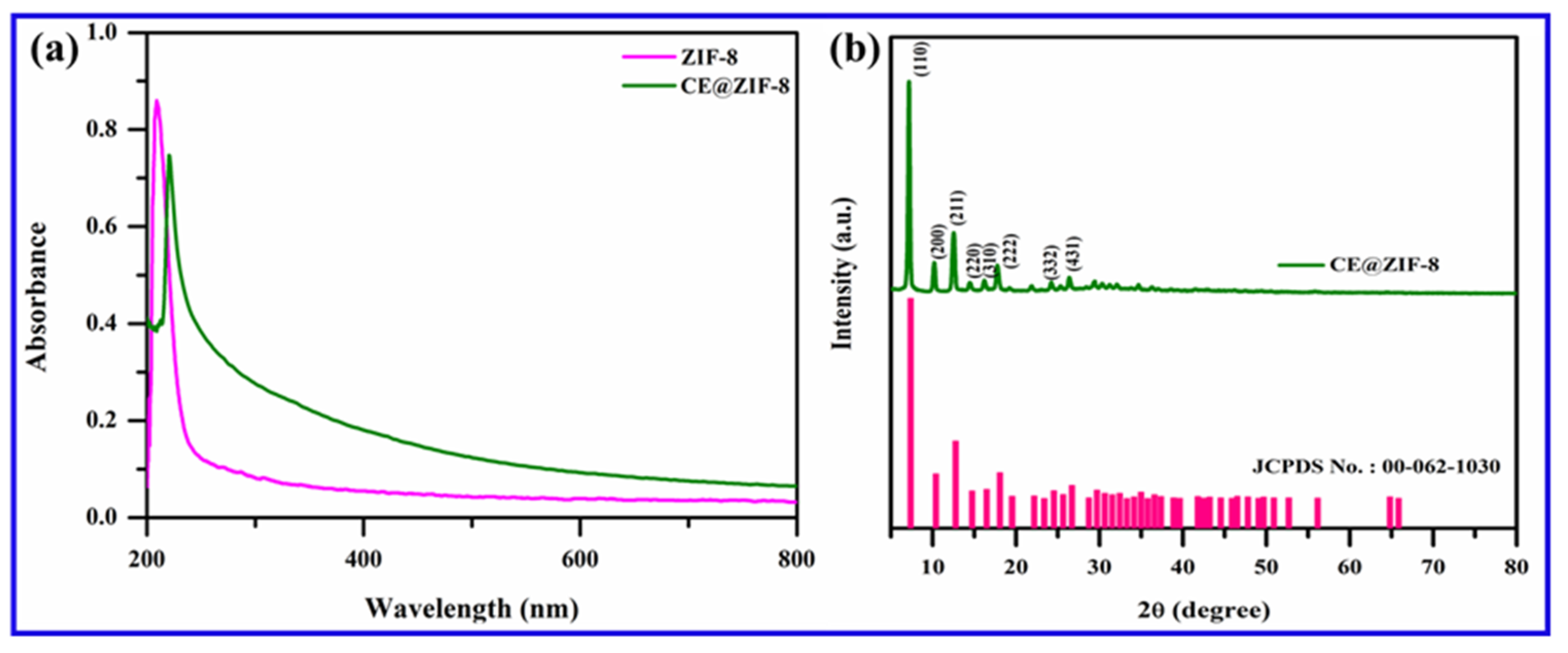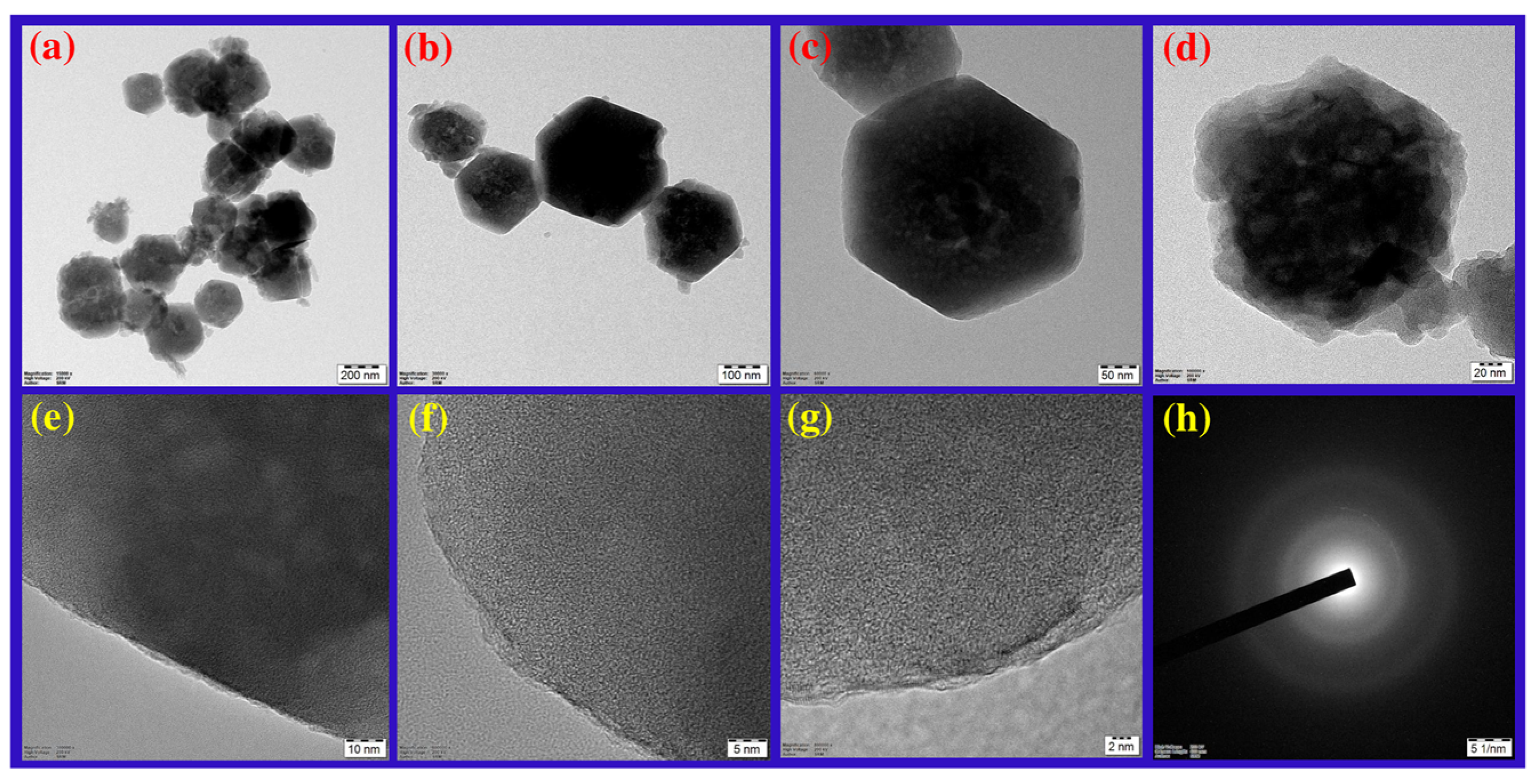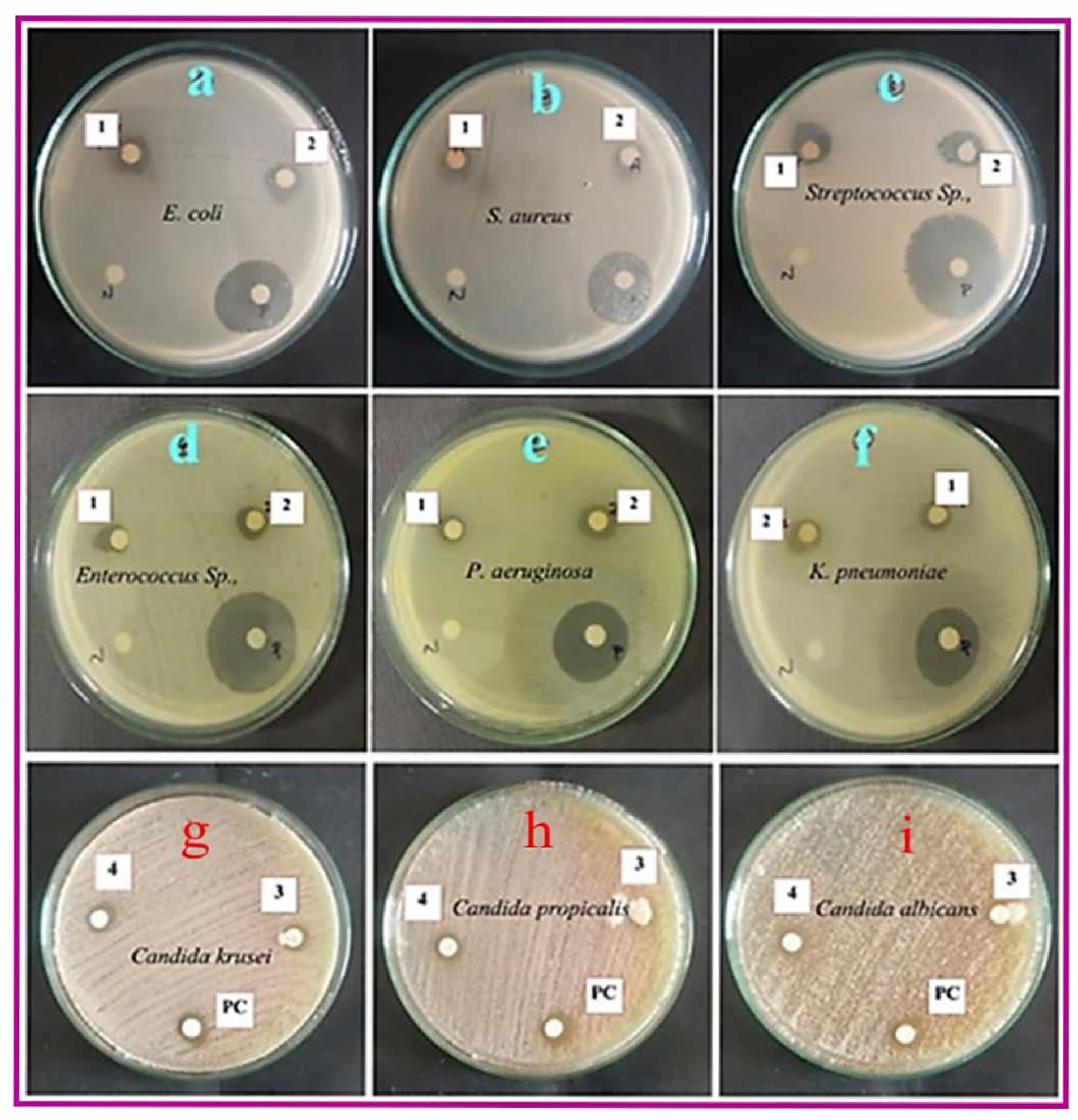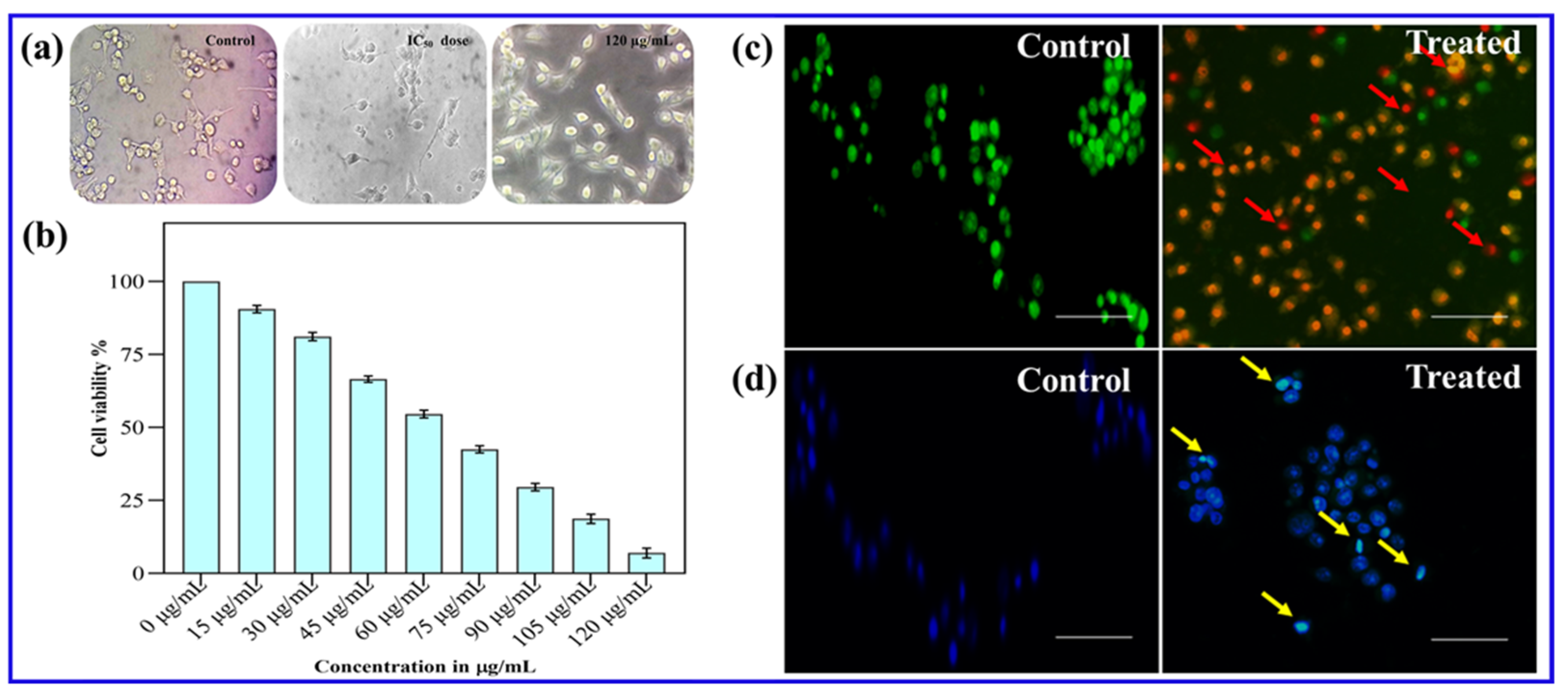Phytofabrication of ZIF-8 Using Mangrove Metabolites for Dual Action Against Drug-Resistant Microbes and Breast Cancer Cells
Abstract
1. Introduction
2. Materials and Methods
2.1. Plant Material and Extraction
2.2. GC-MS Investigation
2.3. Synthesis of ZIF-8 and CE@ZIF-8
2.4. Characterization Techniques
2.5. Antimicrobial Activity
2.5.1. Microbial Strains
2.5.2. Minimum Inhibitory Concentration (MIC) Determination
2.5.3. Antimicrobial Assay
2.6. Cell Lines and Culture Conditions
2.6.1. Cytotoxicity Valuation Assay
2.6.2. Morphological Study
2.6.3. Acridine Orange/Ethidium Bromide (AO/EB) Staining
2.6.4. DAPI Staining
2.7. Assessment of Toxicity Using Artemia salina
2.8. Statistical Analysis
3. Results and Discussion
3.1. Metabolite Analysis
3.2. Synthesis and Characterization of CE@ZIF-8
3.3. Microbicidal Activity
3.4. Cytotoxic Efficacy and Morphological Assessment
3.5. Fluorescent Staining Studies
3.6. Evaluation of Toxicity Using A. salina
4. Conclusions
Author Contributions
Funding
Data Availability Statement
Acknowledgments
Conflicts of Interest
References
- Vaish, S.; Pathak, B. Mangrove synthesized bio-nanomaterial and its applications: A Review. Environ. Nanotechnol. Monit. Manag. 2023, 20, 100866. [Google Scholar] [CrossRef]
- Rehman, S.U.; Azam, F.; Rehman, S.; Rehman, T.U.; Mehmood, A.; Gohar, A.; Samad, A. A review on botanical, phytochemical and pharmacological reports of Conocarpus erectus. Pak. J. Agric. Res. 2019, 32, 212–217. [Google Scholar] [CrossRef]
- Bashir, M.; Uzair, M.; Chaudhry, B.A. A review of phytochemical and biological studies on Conocarpus erectus (Combretaceae). Pak. J. Pharm. Res. 2015, 1, 1–8. [Google Scholar] [CrossRef]
- Afifi, H.S.; Al Marzooqi, H.M.; Tabbaa, M.J.; Arran, A.A. Phytochemicals of Conocarpus spp. as a natural and safe source of phenolic compounds and antioxidants. Molecules 2021, 26, 1069. [Google Scholar] [CrossRef]
- Salam, M.A.; Al-Amin, M.Y.; Salam, M.T.; Pawar, J.S.; Akhter, N.; Rabaan, A.A.; Alqumber, M.A. Antimicrobial resistance: A growing serious threat for global public health. Healthcare 2023, 11, 1946. [Google Scholar] [CrossRef] [PubMed]
- Xie, H.; Liu, X.; Huang, Z.; Xu, L.; Bai, R.; He, F.; Wang, M.; Han, L.; Bao, Z.; Wu, Y.; et al. Nanoscale zeolitic imidazolate framework (ZIF)–8 in cancer theranostics: Current challenges and prospects. Cancers 2022, 14, 3935. [Google Scholar] [CrossRef]
- Wei, X.; Li, N.; Wang, Y.; Xie, Z.; Huang, H.; Yang, G.; Li, T.; Qin, X.; Li, S.; Yang, H.; et al. Zeolitic imidazolate frameworks-based nanomaterials for biosensing, cancer imaging and phototheranostics. Appl. Mater. Today 2021, 23, 100995. [Google Scholar] [CrossRef]
- Wu, Q.; Niu, M.; Chen, X.; Tan, L.; Fu, C.; Ren, X.; Ren, J.; Li, L.; Xu, K.; Zhong, H.; et al. Biocompatible and biodegradable zeolitic imidazolate framework/polydopamine nanocarriers for dual stimulus triggered tumor thermo-chemotherapy. Biomaterials 2018, 162, 132–143. [Google Scholar] [CrossRef]
- Arya, A.; Kumar, S.; Singh, H.; Kain, D.; Ahanger, A.M. Synthesis and characterization of Drymaria cordata mediated encapsulation of Zeolitic Imidazolate Framework-8 and their antibacterial action against drugs resistant bacteria. Inorg. Chem. Commun. 2023, 157, 111394. [Google Scholar] [CrossRef]
- Raju, P.; Muthushanmugam, M.; Rengasamy Lakshminarayanan, R.; Natarajan, S. One-pot synthesis of zeolitic imidazole nanoframeworks with encapsulated Leucas aspera leaf extract: Assessment of anticancer and antimicrobial activities. J. Clust. Sci. 2023, 34, 2977–2989. [Google Scholar] [CrossRef]
- Ahanger, A.M.; Kumar, S.; Arya, A.; Suryavanshi, A.; Kain, D.; Vandana. Synthesis and Encapsulation of Ajuga parviflora Extract with Zeolitic Imidazolate Framework-8 and Their Therapeutic Action against G+ and G–Drug-Resistant Bacteria. ACS Omega 2022, 7, 1671–1681. [Google Scholar] [CrossRef]
- Ilhami, F.B.; Cahyaningrum, S.E.; Wardana, A.P.; Gultom, N.S.; Subekti, H.; Rahmawati, A.; Puspitarini, S. Meniran (Phyllanthus niruri L.) embedded zeolitic imidazolate framework (ZIF-8) nanoparticle for cancer chemotherapy: Supported molecular docking analysis. RSC Adv. 2025, 15, 223–230. [Google Scholar] [CrossRef]
- Wayne, P.A. Performance Standards for Antimicrobial Susceptibility Testing: 20th Informational Supplement; Clinical and Laboratory Standards Institute: Wayne, PA, USA, 2011; M100–S21. [Google Scholar]
- Arsène, M.M.J.; Viktorovna, P.I.; Alla, M.; Mariya, M.; Nikolaevitch, S.A.; Davares, A.K.L.; Yurievna, M.E.; Rehailia, M.; Gabin, A.A.; Alekseevna, K.A.; et al. Antifungal activity of silver nanoparticles prepared using Aloe vera extract against Candida albicans. Vet. World 2023, 16, 18. [Google Scholar] [CrossRef]
- Rajeswaran, S.; Veeraiyan, B.; Saravanan, V.; Manickam, E.; Danaraj, J. Biogenic facile green synthesis of actinobacterium exopolysaccharide-fabricated zinc oxide nanoparticles for the diverse biomedical applications. Biomass Convers. Biorefin. 2023, 15, 787–801. [Google Scholar] [CrossRef]
- Kaplan, Ö.; Tosun, N.G.; İmamoğlu, R.; Türkekul, İ.; Gökçe, İ.; Özgür, A. Biosynthesis and characterization of silver nanoparticles from Tricholoma ustale and Agaricus arvensis extracts and investigation of their antimicrobial, cytotoxic, and apoptotic potentials. JDDST. 2022, 69, 103178. [Google Scholar] [CrossRef]
- Mosmann, T. Rapid colorimetric assay for cellular growth and survival: Application to proliferation and cytotoxicity assays. J. Immunol. Methods 1983, 65, 55–63. [Google Scholar] [CrossRef] [PubMed]
- Kanipandian, N.; Thirumurugan, R. A feasible approach to phyto-mediated synthesis of silver nanoparticles using industrial crop Gossypium hirsutum (cotton) extract as stabilizing agent and assessment of its in vitro biomedical potential. Ind. Crop. Prod. 2014, 55, 1–10. [Google Scholar] [CrossRef]
- Rajabi, S.; Ramazani, A.; Hamidi, M.; Naji, T. Artemia salina as a model organism in toxicity assessment of nanoparticles. Daru J. Pharm. Sci. 2015, 23, 20. [Google Scholar] [CrossRef]
- Yu, J.; Lu, Y. Artemia spp. model-a well-established method for rapidly assessing the toxicity on an environmental perspective. Med. Res. Arch. 2018, 6. [Google Scholar] [CrossRef]
- Talukdar, R.; Wary, S.; Hajowary, R.; Sarma, A.; Tayung, K. Antimicrobial activity of endophytic fungi isolated from some selected ethnomedicinal plants of Assam, India. In Endophytes: Potential Source of Compounds of Commercial and Therapeutic Applications; Springer: Singapore, 2021; pp. 91–102. [Google Scholar]
- Mégarbane, B.; Borron, S.W.; Baud, F.J. Methanol, ethylene glycol and other toxic alcohols. In Haddad and Winchester’s Clinical Management of Poisoning and Drug Overdose; Saunders: Cullowhee, NC, USA, 2007; pp. 611–622. [Google Scholar]
- Asami, E.; Kitami, M.; Ida, T.; Kobayashi, T.; Saeki, M. Anti-inflammatory activity of 2-methoxy-4-vinylphenol involves inhibition of lipopolysaccharide-induced inducible nitric oxidase synthase by heme oxygenase-1. Immunopharmacol. Immunetoxicol. 2023, 45, 589–596. [Google Scholar] [CrossRef]
- Orlo, E.; Russo, C.; Nugnes, R.; Lavorgna, M.; Isidori, M. Natural methoxyphenol compounds: Antimicrobial activity against foodborne pathogens and food spoilage bacteria, and role in antioxidant processes. Foods 2021, 10, 1807. [Google Scholar] [CrossRef]
- Usha, T.; Middha, S.K.; Shanmugarajan, D.; Babu, D.; Goyal, A.K.; Yusufoglu, H.S.; Sidhalinghamurthy, K.R. Gas chromatography-mass spectrometry metabolic profiling, molecular simulation and dynamics of diverse phytochemicals of Punica granatum L. leaves against estrogen receptor. Front. Biosci.-Landmark 2021, 26, 423–441. [Google Scholar] [CrossRef]
- Rakotofina, H.M.E.; Donno, D.; Tombozara, N.; Razafindrakoto, Z.R.; Rakotonandrasana, S.R.; Ramanitrahasimbola, D.; Andrianjaka, S.; Torti, V.; Beccaro, G.L.; Rakotovao, M. Chemical composition, antimicrobial activity, and antioxidant capacity of Micromeria flagellaris Baker and M. madagascariensis Baker: Two endemic species from Madagascar as sources of essential oils. Heliyon 2024, 10, e26865. [Google Scholar] [CrossRef]
- Rajeswaran, S.; Rajan, D.K. Neophytadiene: Biological Activities and Drug Development Prospects. Phytomedicine 2025, 143, 156872. [Google Scholar] [CrossRef] [PubMed]
- Tavanappanavar, A.N.; Mulla, S.I.; Seth, C.S.; Bagewadi, Z.K.; Rahamathulla, M.; Ahmed, M.M.; Farhana, S.A. Phytochemical analysis, GC–MS profile and determination of antibacterial, antifungal, anti-inflammatory, antioxidant activities of peel and seeds extracts (chloroform and ethyl acetate) of Tamarindus indica L. Saudi J. Biol. Sci. 2024, 31, 103878. [Google Scholar] [CrossRef] [PubMed]
- Maddela, N.R.; Thiriveedi, V.; Silviya, L.R. (Eds.) Perspectives of Quorum Quenching in New Drug Development; CRC Press: Boca Raton, FL, USA, 2024. [Google Scholar]
- Salvioni, L.; Galbiati, E.; Collico, V.; Alessio, G.; Avvakumova, S.; Corsi, F.; Tortora, P.; Prosperi, D.; Colombo, M. Negatively charged silver nanoparticles with potent antibacterial activity and reduced toxicity for pharmaceutical preparations. Int. J. Nanomed. 2017, 12, 2517–2530. [Google Scholar] [CrossRef]
- Makhetha, T.A.; Ray, S.C.; Moutloali, R.M. Zeolitic imidazolate framework-8-encapsulated nanoparticle of ag/cu composites supported on graphene oxide: Synthesis and antibacterial activity. ACS Omega 2020, 5, 9626–9640. [Google Scholar] [CrossRef] [PubMed]
- Wyszogrodzka, G.; Marszałek, B.; Gil, B.; Dorożyński, P. Metal-organic frameworks: Mechanisms of antibacterial action and potential applications. Drug Discov. Today 2016, 21, 1009–1018. [Google Scholar] [CrossRef]
- Yan, Y.; Li, Y.; Li, H.; Ma, X.; Tang, Y.; Yi, K.; Lin, X.; Li, J.; Liu, Z. Antimicrobial zeolitic imidazolate frameworks with dual mechanisms of action. ACS Infect. Dis. 2023, 9, 507–517. [Google Scholar] [CrossRef]
- Zaidieh, T.; Smith, J.R.; Ball, K.E.; An, Q. ROS as a novel indicator to predict anticancer drug efficacy. BMC Cancer 2019, 19, 1224. [Google Scholar] [CrossRef]
- Zhang, C.; Wang, X.; Du, J.; Gu, Z.; Zhao, Y. Reactive oxygen species—regulating strategies based on nanomaterials for disease treatment. Adv. Sci. 2021, 8, 2002797. [Google Scholar] [CrossRef] [PubMed]
- Raju, P.; Natarajan, S. Anticancer, anti-biofilm and antimicrobial activity of fucoidan-loaded zeolitic imidazole framework fabricated by one-pot synthesis method. Appl. Nanosci. 2023, 13, 1919–1937. [Google Scholar] [CrossRef]
- Li, X.; Gao, Y. Synergistically fabricated polymeric nanoparticles featuring dual drug delivery system to enhance the nursing care of cervical cancer. Process Biochem. 2020, 98, 254–261. [Google Scholar] [CrossRef]
- Gao, S.; Lv, R.; Hao, N.; Wang, H.; Lv, Y.; Li, Y.; Ji, Y.; Liu, Y. Fabrication of pH/photothermal-responsive ZIF-8 nanocarriers loaded with baicalein for effective drug delivery and synergistic chem-photothermal effects. Colloids Surf. A Physicochem. Eng. Asp. 2023, 668, 131401. [Google Scholar] [CrossRef]
- Govindan, L.; Raju, P.; Kannaiah, S.; Arunprakash, N.; Alqahtani, S.; Chidambaram, K. Fabrication of Achyranthes aspera extract loaded ZIF-8 nanocomposite for lung cancer treatment, an in vitro assessment. 3 Biotech 2025, 15, 191. [Google Scholar] [CrossRef]
- Abdel-Hameed, E.S.S.; Bazaid, S.A.; Shohayeb, M.M.; El-Sayed, M.M.; El-Wakil, E.A. Phytochemical studies and evaluation of antioxidant, anticancer and antimicrobial properties of Conocarpus erectus L. growing in Taif, Saudi Arabia. Eur. J. Med. Plants 2012, 2, 93–112. [Google Scholar] [CrossRef]







| Peak | R. Time | Area (%) | Height (%) | Compound Name |
|---|---|---|---|---|
| 1 | 4.104 | 25.20 | 7.25 | Dimethylsulfoxonium formylmethylide |
| 2 | 6.591 | 1.14 | 0.74 | 2-Furancarboxaldehyde, 5-methyl- |
| 3 | 7.488 | 0.78 | 1.04 | 3-Methylpyridazine |
| 4 | 8.587 | 1.12 | 1.76 | Benzyl alcohol |
| 5 | 9.592 | 1.27 | 0.98 | Hydrouracil, 1-methyl- |
| 6 | 11.487 | 1.72 | 2.14 | Ethanone, 1-(2-methylphenyl)- |
| 7 | 13.626 | 0.41 | 0.85 | 2-Methoxy-4-vinylphenol |
| 8 | 15.654 | 0.55 | 1.08 | Phenol, 2-Methoxy-4-(1-propenyl)-, (Z)- |
| 9 | 16.453 | 0.58 | 1.15 | 1,1,4,5,6-Pentamethyl-2,3-dihydro-1H-indene |
| 10 | 17.501 | 2.84 | 5.66 | Diethyl Phthalate |
| 11 | 17.797 | 2.42 | 3.37 | 5-Isopropenyl-2-methylcyclopent-1-enecarboxaldehyde |
| 12 | 18.302 | 2.22 | 1.66 | 1,1-Dimethyl-1,2,3,5,7,8,9,9a-octahydro-benzocyclohepten-6-one |
| 13 | 19.160 | 0.42 | 1.03 | 1-Dodecanol, 3,7,11-trimethyl- |
| 14 | 19.646 | 1.72 | 2.01 | Tetradecanoic acid |
| 15 | 20.100 | 1.63 | 1.94 | 5,5,8a-Trimethyl-3,5,6,7,8,8a-hexahydro-2H-chromene |
| 16 | 20.429 | 6.46 | 12.58 | Neophytadiene |
| 17 | 20.693 | 1.10 | 2.93 | Neophytadiene |
| 18 | 20.902 | 2.67 | 5.46 | Neophytadiene |
| 19 | 21.388 | 2.00 | 4.77 | Hexadecanoic acid, methyl ester |
| 20 | 21.997 | 22.53 | 17.01 | n-Hexadecanoic acid |
| 21 | 23.144 | 0.51 | 1.48 | 9,12-Octadecadienoic acid (Z,Z)-, methyl ester |
| 22 | 23.325 | 0.48 | 1.21 | Phytol |
| 23 | 23.732 | 12.14 | 9.17 | cis-9-Hexadecenal |
| 24 | 23.963 | 7.46 | 11.27 | Octadecanoic acid |
| 25 | 24.787 | 0.64 | 1.45 | E-10,13,13-Trimethyl-11-tetradecen-1-ol acetate |
| Total | 100.00 | 100.00 | ||
| S. No | Name of the Strains | 7.8 μg/mL | 15.6 μg/mL | 31.25 μg/mL | 62.5 μg/mL | 125.0 μg/mL | 250.0 μg/mL | (+) ve C | (−) ve C |
|---|---|---|---|---|---|---|---|---|---|
| 1. | E. coli. | +++ | +++ | +++ | ++ | + | * | −− | +++ |
| 2. | S. aureus | +++ | +++ | +++ | ++ | + | * | −− | +++ |
| 3. | Streptococcus Sp. | +++ | +++ | ++ | * | −− | −− | −− | +++ |
| 4. | Enterococcus Sp. | +++ | +++ | +++ | ++ | + | * | −− | +++ |
| 5. | P. aeruginosa | +++ | +++ | ++ | + | * | −− | −− | +++ |
| 6. | K. pneumoniae | +++ | +++ | ++ | + | * | −− | −− | +++ |
| S. No | Name of the Strains | 7.8 μg/mL | 15.6 μg/mL | 31.25 μg/mL | 62.5 μg/mL | 125.0 μg/mL | 250.0 μg/mL | (+) ve C | (−) ve C |
|---|---|---|---|---|---|---|---|---|---|
| 1. | C. krusei | +++ | +++ | ++ | ++ | + | * | −− | +++ |
| 2. | C. propicalis | +++ | +++ | ++ | ++ | + | * | −− | +++ |
| 3. | C. albicans | +++ | +++ | ++ | ++ | + | * | −− | +++ |
| S. No | Name of the Strains | Zone of Inhibition (mm) | |||
|---|---|---|---|---|---|
| 75 μg/mL | 150 μg/mL | (+) ve C | (−) ve C | ||
| 1. | E. coli. | 5.7 ± 0.52 | 8.1 ± 0.26 | 18.2 ± 0.15 | −− |
| 2. | S. aureus | 4.5 ± 0.25 | 7.6 ± 0.45 | 15.6 ± 0.36 | −− |
| 3. | Streptococcus Sp. | 8.3 ± 0.51 | 12.2 ± 0.47 | 24.4 ± 0.43 | −− |
| 4. | Enterococcus Sp. | 4.2 ± 0.45 | 8.4 ± 0.55 | 21.3 ± 0.3 | −− |
| 5. | P. aeruginosa | 6.3 ± 0.35 | 10.1 ± 0.41 | 16.8 ± 0.2 | −− |
| 6. | K. pneumoniae | 5.2 ± 0.4 | 11.5 ± 0.32 | 17.7 ± 0.45 | −− |
| S. No | Name of the Strains | Zone of Inhibition (mm) | |||
|---|---|---|---|---|---|
| 100 μg/mL | 200 μg/mL | (+) ve C | (−) ve C | ||
| 1. | C. krusei | 3.2 ± 0.36 | 7.2 ± 0.15 | 10.2 ± 0.41 | −− |
| 2. | C. propicalis | 3.3 ± 0.45 | 5.1 ± 0.25 | 14.4 ± 0.3 | −− |
| 3. | C. albicans | 3.1 ± 0.35 | 6.3 ± 0.32 | 12.1 ± 0.4 | −− |
| Concentration | % of Cell Viability |
|---|---|
| 0 (NC) | 100 |
| 15 µg/mL | 90.6 ± 1.26 |
| 30 µg/mL | 79.6 ±1.42 |
| 45 µg/mL | 65.4 ± 1.11 |
| 60 µg/mL | 53.3 ±1.30 |
| 75 µg/mL | 41.4 ± 1.20 |
| 90 µg/mL | 29.9 ± 1.27 |
| 105 µg/mL | 17.1 ± 1.55 |
| 120 µg/mL | 5.6 ± 1.63 |
Disclaimer/Publisher’s Note: The statements, opinions and data contained in all publications are solely those of the individual author(s) and contributor(s) and not of MDPI and/or the editor(s). MDPI and/or the editor(s) disclaim responsibility for any injury to people or property resulting from any ideas, methods, instructions or products referred to in the content. |
© 2025 by the authors. Licensee MDPI, Basel, Switzerland. This article is an open access article distributed under the terms and conditions of the Creative Commons Attribution (CC BY) license (https://creativecommons.org/licenses/by/4.0/).
Share and Cite
Rajeswaran, S.; Kumarikrishna, M.S.; Giriprasath, A.; Sridhar, K.; Anbazhagan, M.; Vadivel, S.; Bhaswant, M. Phytofabrication of ZIF-8 Using Mangrove Metabolites for Dual Action Against Drug-Resistant Microbes and Breast Cancer Cells. Biomimetics 2025, 10, 755. https://doi.org/10.3390/biomimetics10110755
Rajeswaran S, Kumarikrishna MS, Giriprasath A, Sridhar K, Anbazhagan M, Vadivel S, Bhaswant M. Phytofabrication of ZIF-8 Using Mangrove Metabolites for Dual Action Against Drug-Resistant Microbes and Breast Cancer Cells. Biomimetics. 2025; 10(11):755. https://doi.org/10.3390/biomimetics10110755
Chicago/Turabian StyleRajeswaran, Srinath, Mithuna Shaji Kumarikrishna, Aneesh Giriprasath, Kandi Sridhar, Murugan Anbazhagan, Siva Vadivel, and Maharshi Bhaswant. 2025. "Phytofabrication of ZIF-8 Using Mangrove Metabolites for Dual Action Against Drug-Resistant Microbes and Breast Cancer Cells" Biomimetics 10, no. 11: 755. https://doi.org/10.3390/biomimetics10110755
APA StyleRajeswaran, S., Kumarikrishna, M. S., Giriprasath, A., Sridhar, K., Anbazhagan, M., Vadivel, S., & Bhaswant, M. (2025). Phytofabrication of ZIF-8 Using Mangrove Metabolites for Dual Action Against Drug-Resistant Microbes and Breast Cancer Cells. Biomimetics, 10(11), 755. https://doi.org/10.3390/biomimetics10110755






